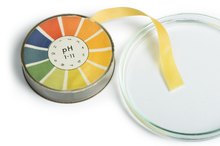Average Amount of Stomach Acid in the Human Stomach
Your stomach secretes a variety of fluids that aid in digestion, including stomach acid. Stomach acid is composed primarily of hydrochloric acid, making the stomach a very acidic environment with a pH of 1 to 2. The body closely regulates the production and secretion of stomach acid, since too much or too little has adverse effects on your digestive and overall health.
Functions
At the onset of eating, G cells present in the stomach, duodenum and pancreas release a hormone called gastrin. Gastrin then stimulates parietal cells in the stomach to produce and secrete stomach acid and other fluids. Stomach acid activates digestive enzymes, denatures large protein molecules for easier digestion and kills ingested microorganisms, such as bacteria. The duodenum secretes large quantities of sodium bicarbonate as highly acidic stomach contents move into the small intestine. This helps neutralize the pH to prevent damage to the other digestive organs.
- At the onset of eating, G cells present in the stomach, duodenum and pancreas release a hormone called gastrin.
- Gastrin then stimulates parietal cells in the stomach to produce and secrete stomach acid and other fluids.
Stomach Acid Test and Average Levels
Pepsin Enzyme Function
Learn More
Your physician will use a stomach acid test to measure the amount and pH of your stomach acid 3. The content of fluid in your stomach should average between 20 and 100mL with a pH of 1.5 to 3.5, according to MedlinePlus 3.
Hypochlorhydria
Hypochlorhydria and achlorhydria refer to the production of little or no stomach acid. The absence of stomach acid has several complications since it aids in food digestion. Without stomach acid, proteins move into the small intestine intact and too big for the body to absorb. This can lead to protein malabsorption and malnutrition, according to Dr. Sarah Myhill. The absorption of vitamin B-12 also depends on sufficient stomach acid. Mild vitamin B-12 deficiency can lead to depression, fatigue and poor memory; prolonged deficiency can cause irreversible brain and nerve damage. Lastly, the absence of stomach acid can lead to infections caused by ingested microorganisms.
- Hypochlorhydria and achlorhydria refer to the production of little or no stomach acid.
- Lastly, the absence of stomach acid can lead to infections caused by ingested microorganisms.
Hyperchlorhydria
Pancreatitis Caused by Vitamin B12 Deficiency
Learn More
Hyperchlorhydria is the condition of too much acid in the stomach fluid. It can also refer to stomach acid with a pH that is too low. Mucous cells along the stomach lumen secrete mucus to prevent stomach acid from reaching and damaging the stomach wall, which can cause sores called peptic ulcers. Peptic ulcers are characterized by burning stomach pain that worsens after eating. Spicy foods, stress, alcohol and smoking exacerbate ulcer symptoms.
- Hyperchlorhydria is the condition of too much acid in the stomach fluid.
- Peptic ulcers are characterized by burning stomach pain that worsens after eating.
Related Articles
References
- Colorado State University; Gastric Secretions; R. Bowen; January 2002
- “Human Physiology: An Integrated Approach”; Dee Unglaub Silverthorn, Ph.D.; 2006
- MedlinePlus; Stomach acid test; June 2011
- Doctor Myhill; Hypochlorhydria - lack of stomach acid - can cause lots of problems; August 2010
- MedlinePlus; Peptic Ulcer; June 2011
- Willet SG, Mills JC. Stomach organ and cell lineage differentiation: from embryogenesis to adult homeostasis. Cell Mol Gastroenterol Hepatol. 2016;2(5):546-559. doi:10.1016/j.jcmgh.2016.05.006
- Gropper SS, Smith JL, Groff JL. Advanced Nutrition and Human Metabolism. 6th ed. Belmont, CA: Wadsworth Publishing Company; 2013.
- Smolin LA, Grosvenor, MB. Nutrition: Science and Applications. 4th ed. Hoboken, NJ: Wiley Publishing Company; 2016.
- Wallace M. Your Digestive System and How It Works. National Institute of Diabetes and Digestive and Kidney Diseases (NIDDK). 2013.
Writer Bio
Ann Jamerson began writing ads and informational brochures for research trials in 2003 during an internship at an alcohol and drug research center. She assisted in writing and editing manuscripts concerning the breast cancer genes and psychosocial effects on affected patients. She received her Bachelor of Science in biology from the University of California, San Diego and is currently attending nursing school.







